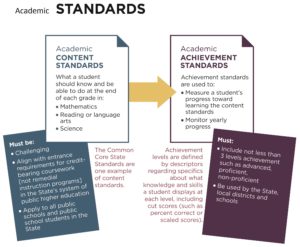Welcome to Section 2 of the Stakeholder Guide to the Every Student Succeeds Act (ESSA). This guide provides Parent Center staff and their advocacy partners with an understanding of key provisions in ESSA so that they may become meaningfully involved in how the law is now planned and implemented by the states. The guide is presented on the CPIR website in several sections (web pages) to enhance your quick access to its many topics.
This is Section 2, where you’ll find information about ESSA’s:
- Academic content standards and achievement standards
- Alternate academic achievement standards for students with the most significant cognitive disabilities
- English language proficiency standards
January 2017
A collaborative publication of the Center for Parent Information and Resources (CPIR) and The Advocacy Institute
________________________
Not what are you looking for?
Go back to Section 1 of the Stakeholder Guide.
See other sections of the guide.
________________________
Academic Content Standards and Achievement Standards in ESSA
 ESSA requires states to provide an assurance in the state’s plan that it has adopted:
ESSA requires states to provide an assurance in the state’s plan that it has adopted:
1 | challenging academic content standards in mathematics, reading or language arts, and science that:
- align with entrance requirements for credit-bearing coursework in the system of public higher education in the state and relevant state career and technical education standards; and
- apply to all public schools and public school students in the state, including students with disabilities.
2 | academic achievement standards that are:
- aligned with the content standards;
- include not less than 3 levels of achievement;
- expected of all public school students in the state except for students identified with the most significant cognitive disabilities. (Section 1111 (b)(1))
The law requires that the state’s challenging academic content standards in mathematics, reading or language arts, and science apply to all public schools and public school students in the state, including students with disabilities. This requirement is pivotal to ensuring that students with disabilities are provided with special education services and supports that are designed to enable access to the standards.
PARENT CENTER ACTION ITEMS
Be sure your state plan clearly articulates the requirement that students with disabilities are expected to be instructed in the same academic content standards as all other students. Specifically, how will the state ensure that Individualized Education Programs (IEPs) are aligned to state academic content standards for the student’s enrolled grade? Share the November 16, 2015 U.S. Dept. of Education Dear Colleague Letter on Free Appropriate Public Education, available online at:
https://sites.ed.gov/IDEA/idea-files/osep-dear-colleague-letter-on-free-and-appropriate-public-education-fape/
Ensure that the state has a plan to communicate the importance of holding students with disabilities to the same state academic content and achievement standards as their non-disabled peers.
Alternate Academic Achievement Standards for Students with the Most Significant Cognitive Disabilities
ESSA allows only one exception to the requirements that both the state’s academic content standards and academic achievement standards apply to all students.
Specifically, the state may, through a documented and validated standards-setting process, adopt alternate academic achievement standards for students with the most significant cognitive disabilities, provided those standards—
~are aligned with the challenging State academic content standards;
~promote access to the general education curriculum, consistent with the Individuals with Disabilities Education Act (IDEA);
~reflect professional judgment as to the highest possible standards achievable by such students;
~are designated in the IEP developed under section 614(d)(3) of IDEA for each such student as the academic achievement standards that will be used for the student; and
~are aligned to ensure that a student who meets the alternate academic achievement standards is on track to pursue postsecondary education or employment, consistent with the purposes of the Workforce Innovation and Opportunity Act to maximize opportunities for individuals with significant disabilities for competitive integrated employment. (Section 1111 (b)(1)(E))
Importantly, ESSA prohibits states from developing or implementing any other alternate academic achievement standards for use in meeting the Act’s requirements (Section 1111 (b)(1)(E)(ii). This provision expressly prevents states from developing any alternate assessments other than an alternate assessment based on alternate achievement standards developed exclusively for students with the most significant cognitive disabilities, such as the Alternate Assessment on Modified Achievement Standards previously authorized by the U.S. Dept. of Education in 2005 and rescinded in 2015.
The restriction on alternate academic achievement standards is designed to ensure that the vast majority of students with disabilities will be instructed in the academic content standards for their enrolled grade and assessed against those standards.
English Language Proficiency Standards
States must also have in place English language proficiency (ELP) standards (derived from the domains of speaking, listening, reading, and writing) for English learners that address the different proficiency levels of English learners and that are aligned with their academic standards. (Section 1111 (b)(2))
Back to top
________________________
Authorship | This guide has been produced in a partnership between the Center for Parent Information and Resources (CPIR) and The Advocacy Institute under a cooperative agreement from the U.S. Department of Education Office of Special Education Programs. The Center for Parent Information and Resources is a project of the Statewide Parent Advocacy Network, Inc.
________________________
Index of Sections in the Stakeholder Guide to the ESSA
The Stakeholder Guide to the ESSA is presented in separate sections. Which section would you like to read now?
1 | Background, Structure of the ESSA, Implementation Timeline, State Plans, Stakeholder Engagement
2 | Academic Content Standards and Achievement Standards (You’re already here!)
4 | Statewide Accountability System


